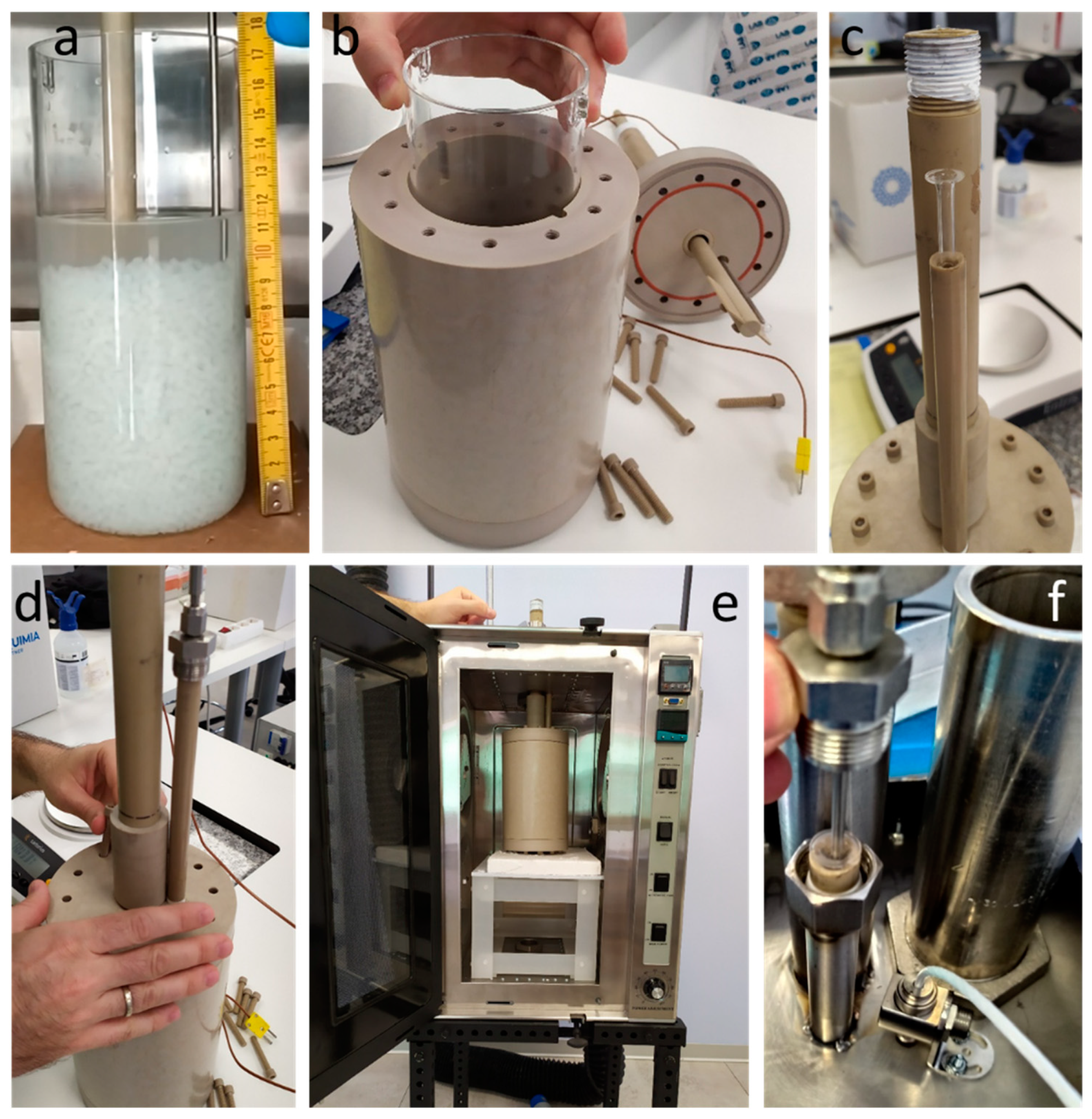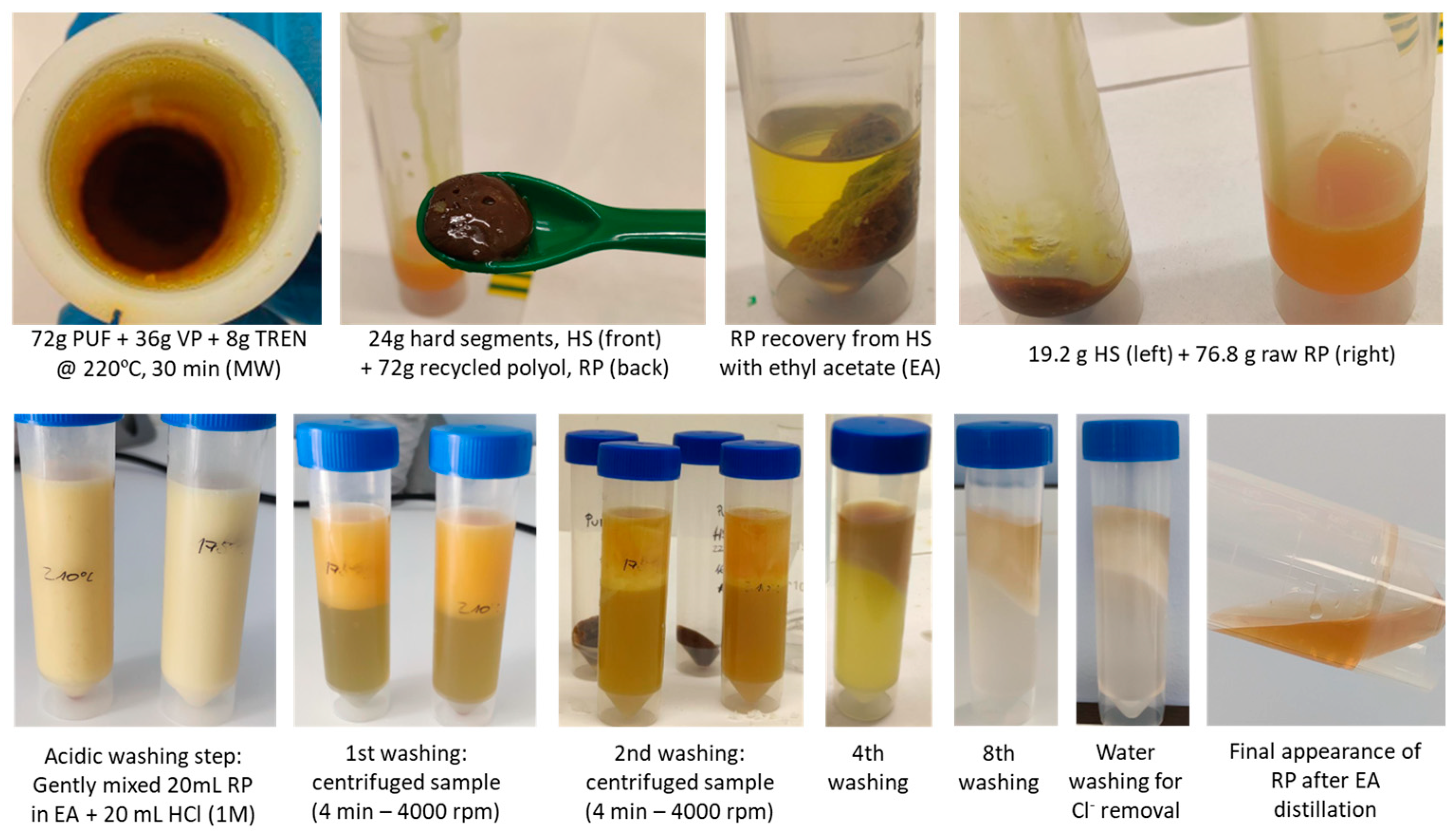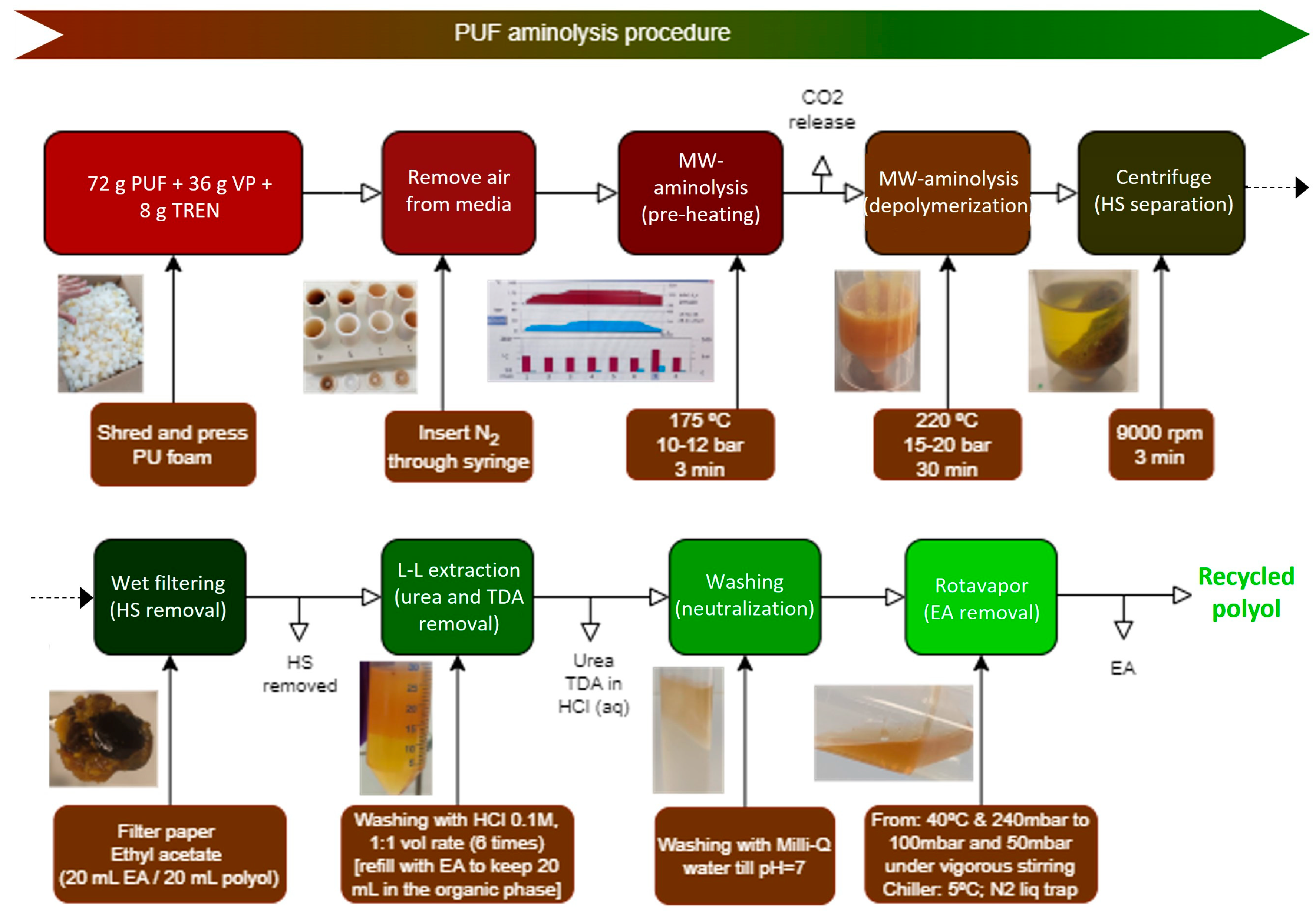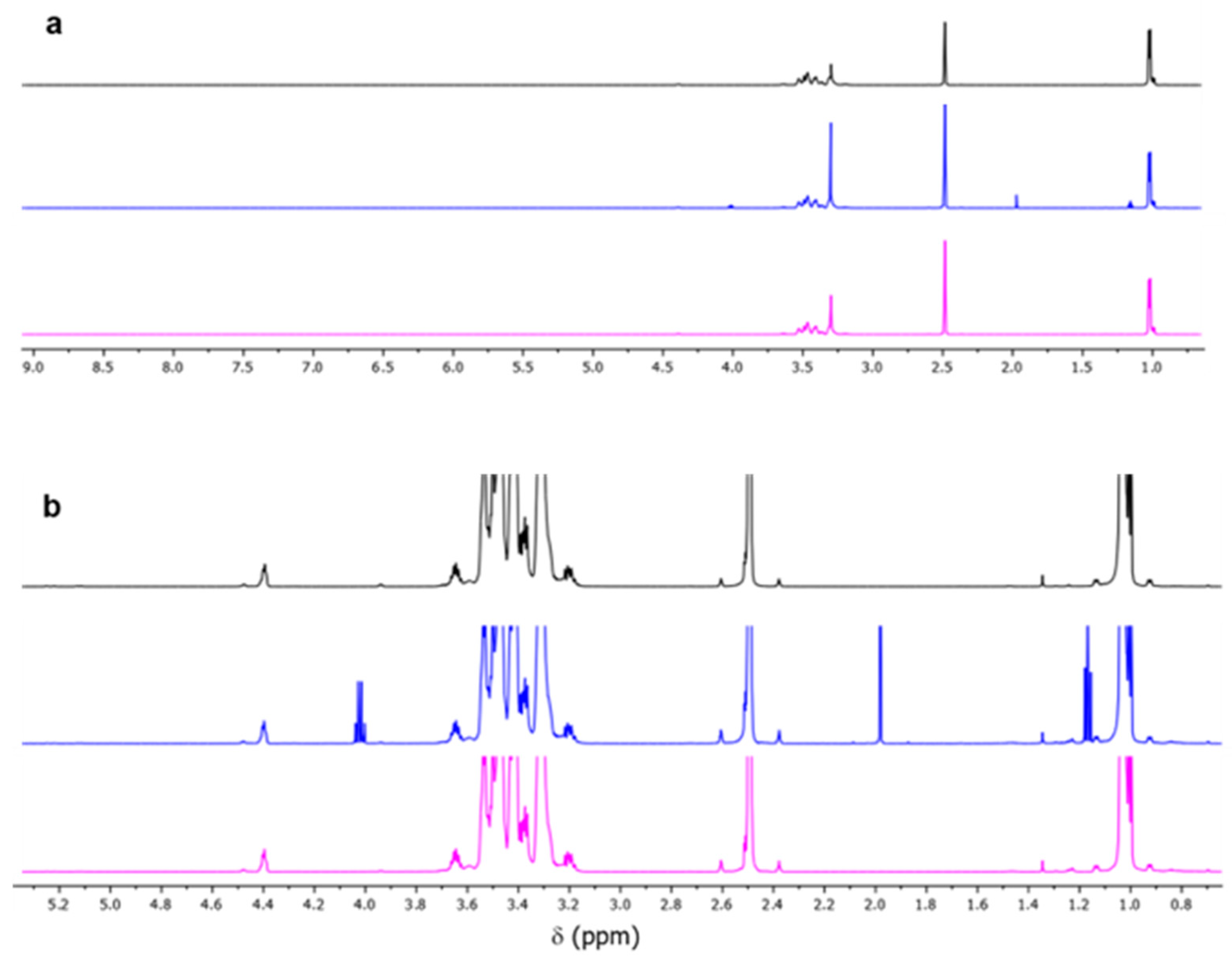Microwave-Assisted PUF Aminolysis: Experimental Validation, Scaling Process Assessment and LCA Evaluation
Abstract
1. Introduction
2. Materials and Methods
2.1. Experimental Microwave-Assisted Aminolysis Set-Up
2.2. MW-Assisted Aminolysis Procedure
2.3. Materials Characterization Techniques
3. Conceptual PUF Recycling Scale-Up Design
- Semi-continuous stirred-tank reactor capacity: 300 L;
- Same PUF/solvent/reagent weight ratio as that used in bench tests (PUF:VP:TREN = 10:5:1 wt%);
- The energy for pre-squeezing shredded PUF and loading the reactor was considered negligible;
- 100% conversion of PUF was assumed;
- Same reaction time and yield as in bench tests were adopted;
- An approach to keep the scaled tank stirred was to scale it as follows the proportion of shredded PUF/1 L reactor → 22.5 kg PUF/300 L (steady-state reactor loading);
- Mixer–settlers were assumed to be used for liquid–liquid extraction, i.e., extraction of TDA from the organic phase (recycled polyol + ethyl acetate) using an aqueous HCl solution;
- The distillation processes were modeled as evaporating units;
- The recirculation of solvents (ethyl acetate and HCl) and part of the recycled polyol are envisioned to reduce the consumption of raw materials and environmental footprint;
- The hard segments and TDA are the only waste flows;
- The analysis excludes the mechanical PUF waste feeding and product removal systems.
Mathematical Modeling
4. Life Cycle Assessment (LCA)
- Global warming (kg CO2 eq) measures the contribution of an activity or product to climate change, expressed in CO2 equivalents. It includes other greenhouse gases like methane or nitrogen oxides, which are converted to CO2 based on their global warming potential;
- Fine particulate matter formation (kg PM2.5-eq) assesses the formation of fine particulate matter (PM2.5) in the air, which can have negative effects on human health and the environment. These particles can cause respiratory issues and contribute to air pollution;
- Terrestrial acidification (kg SO2-eq) measures the impact of acidic emissions (such as sulfur dioxide, SO2) that can acidify the soil and harm ecosystems. Acidification lowers soil quality and can affect biodiversity;
- Fossil resource scarcity (kg oil eq) estimates the amount of non-renewable fossil resources, like oil, that are depleted due to extraction and use. This category reflects the availability and sustainability of these resources over time;
- Water consumption (m3) measures the total volume of water used throughout the lifecycle of a product or activity, including water consumed in industrial processes, agricultural irrigation and other uses. Water scarcity is a key concern in many regions.
5. Results and Discussion
5.1. Experimental PUF Recycling: Materials Characterization and Process Yield
5.2. Energy Consumption Assessment of an Upscaled MW-Driven PUF Depolymerization Process
5.3. Life Cycle Analysis (LCA)
6. Conclusions
Author Contributions
Funding
Institutional Review Board Statement
Informed Consent Statement
Data Availability Statement
Acknowledgments
Conflicts of Interest
Abbreviations
| CAPEX | Capital expenditure |
| EA | Ethyl acetate |
| LCA | Life cycle assessment |
| MW | Microwave-assisted |
| NMR | Nuclear magnetic resonance |
| OPEX | Operating costs |
| PEEK | Polyether–ether–ketone |
| PUF | Polyurethane foam |
| RP | Recycled polyol |
| SEC/UV-MALS-RI | Size-exclusion chromatography combined with ultraviolet, multiangle laser light scattering and refractive index |
| TDA | Toluene diamine |
| TREN | Tris(2-aminoethyl)amine |
| VP | Virgin polyol |
References
- Statista Research Department. Global Polyurethane Market Volume 2015–2030; Statista: Hamburg, Germany, 2024. [Google Scholar]
- Rossignolo, G.; Malucelli, G.; Lorenzetti, A. Recycling of polyurethanes: Where we are and where we are going. Green Chem. 2024, 26, 1132–1152. [Google Scholar] [CrossRef]
- Kemona, A.; Piotrowska, M. Polyurethane recycling and disposal: Methods and prospects. Polymers 2020, 12, 1752. [Google Scholar] [CrossRef] [PubMed]
- Deng, Y.; Dewil, R.; Appels, L.; Ansart, R.; Baeyens, J.; Kang, Q. Reviewing the thermo-chemical recycling of waste polyurethane foam. J. Environ. Manag. 2021, 278, 111527. [Google Scholar] [CrossRef] [PubMed]
- Simón, D.; Borreguero, A.M.; de Lucas, A.; Rodríguez, J.F. Recycling of polyurethanes from laboratory to industry, a journey towards the sustainability. Waste Manag. 2018, 76, 147–171. [Google Scholar] [CrossRef]
- Wu, C.H.; Chang, C.Y.; Cheng, C.M.; Huang, H.C. Glycolysis of waste flexible polyurethane foam. Polym. Degrad. Stab. 2003, 80, 103–111. [Google Scholar] [CrossRef]
- Wieczorek, K.; Bukowski, P.; Stawiński, K.; Ryłko, I. Recycling of Polyurethane Foams via Glycolysis: A Review. Materials 2024, 17, 4617. [Google Scholar] [CrossRef]
- Heiran, R.; Ghaderian, A.; Reghunadhan, A.; Sedaghati, F.; Thomas, S.; Haghighi, A.H. Glycolysis: An efficient route for recycling of end-of-life polyurethane foams. J. Polym. Res. 2021, 28, 22. [Google Scholar] [CrossRef]
- Zhou, W.; Neumann, P.; Al Batal, M.; Rominger, F.; Hashmi, A.S.K.; Schaub, T. Depolymerization of Technical-Grade Polyamide 66 and Polyurethane Materials through Hydrogenation. Chem. Sus. Chem. 2021, 14, 4176–4180. [Google Scholar] [CrossRef]
- Gama, N.; Godinho, B.; Madureira, P.; Marques, G.; Barros-Timmons, A.; Ferreira, A. Polyurethane Recycling Through Acidolysis: Current Status and Prospects for the Future. J. Polym. Environ. 2024, 32, 4777–4793. [Google Scholar] [CrossRef]
- Gama, N.; Godinho, B.; Marques, G.; Silva, R.; Barros-Timmons, A.; Ferreira, A. Recycling of polyurethane by acidolysis: The effect of reaction conditions on the properties of the recovered polyol. Polymer 2021, 219, 123561. [Google Scholar] [CrossRef]
- Gama, N.; Godinho, B.; Marques, G.; Silva, R.; Barros-Timmons, A.; Ferreira, A. Recycling of polyurethane scraps via acidolysis. Chem. Eng. J. 2020, 395, 125102. [Google Scholar] [CrossRef]
- Bhandari, S.; Gupta, P. Chemical Depolymerization of Polyurethane Foam via Ammonolysis and Aminolysis. In Recycling of Polyurethane Foams; William Andrew: Norwich, NY, USA, 2018; pp. 77–87. [Google Scholar] [CrossRef]
- Grdadolnik, M.; Zdovc, B.; Drinčić, A.; Onder, O.C.; Utroša, P.; Ramos, S.G.; Ramos, E.D.; Pahovnik, D.; Žagar, E. Chemical Recycling of Flexible Polyurethane Foams by Aminolysis to Recover High-Quality Polyols. ACS Sust. Chem. Eng. 2023, 11, 10864–10873. [Google Scholar] [CrossRef]
- Grdadolnik, M.; Drinčić, A.; Oreški, A.; Onder, O.C.; Utroša, P.; Pahovnik, D.; Žagar, E. Insight into Chemical Recycling of Flexible Polyurethane Foams by Acidolysis. ACS Sust. Chem. Eng. 2022, 10, 1323–1332. [Google Scholar] [CrossRef]
- Stefanidis, G.D.; Muñoz, A.N.; Sturm, G.S.J.; Stankiewicz, A. A helicopter view of microwave application to chemical processes: Reactions, separations, and equipment concepts. Rev. Chem. Eng. 2014, 30, 233–259. [Google Scholar] [CrossRef]
- Goyal, H.; Chen, T.Y.; Chen, W.; Vlachos, D.G. A review of microwave-assisted process intensified multiphase reactors. Chem. Eng. J. 2022, 430, 133183. [Google Scholar] [CrossRef]
- Stankiewicz, A.I.; Nigar, H. Beyond electrolysis: Old challenges and new concepts of electricity-driven chemical reactors. React. Chem. Eng. 2020, 5, 1005–1016. [Google Scholar] [CrossRef]
- Frisa-Rubio, A.; González-Niño, C.; Royo, P.; García-Polanco, N.; Martínez-Hernández, D.; Royo-Pascual, L.; Fiesser, S.; Žagar, E.; García-Armingol, T. Chemical recycling of plastics assisted by microwave multi-frequency heating. Clean Eng. Technol. 2021, 5, 100297. [Google Scholar] [CrossRef]
- Češarek, U.; Pahovnik, D.; Žagar, E. Chemical recycling of aliphatic polyamides by microwave-assisted hydrolysis for efficient monomer recovery. ACS Sustain. Chem. Eng. 2020, 8, 16274–16282. [Google Scholar] [CrossRef]
- De La Hoz, A.; Carrillo, J.; Herrero, M.A.; Prieto, P.; Al Díaz-Ortiz, Á. 7—Reproducibility and Scalability of Microwave-Assisted Reactions. In Microwave Heating; InTech Open: London, UK, 2011. [Google Scholar] [CrossRef]
- Julian, I.; Pedersen, C.M.; Jensen, A.B.; Baden, A.K.; Hueso, J.L.; Friderichsen, A.V.; Birkedal, H.; Mallada, R.; Santamaria, J. From bench scale to pilot plant: A 150x scaled-up configuration of a microwave-driven structured reactor for methane dehydroaromatization. Catal. Today 2022, 383, 21–30. [Google Scholar] [CrossRef]
- Julian, I.; García-Jiménez, A.; Aguado, A.; Arenal, C.; Calero, A.; Campos, V.; Escobar, G.; López-Buendía, A.M.; Romero, D.; Verdejo, E.; et al. Advances in the circularity of end-of-life fibre-reinforced polymers by microwave intensification. Chem. Eng. Proc.—Proc. Intensif. 2022, 178, 109015. [Google Scholar] [CrossRef]
- Goyal, H.; Mehdad, A.; Lobo, R.F.; Stefanidis, G.D.; Vlachos, D.G. Scaleup of a Single-Mode Microwave Reactor. Ind. Eng. Chem. Res. 2020, 59, 2516–2523. [Google Scholar] [CrossRef]
- Fresneda-Cruz, A.; Murillo-Ciordia, G.; Figueirêdo, M.B.; Tovar-Lasheras, F.; Farra, A.A.L.; Arauzo, J.; Julian, I. Microwave-assisted pyrolysis of waste LDPE: Unveiling the role of induced gas-solid thermal gradients on pyrolysis oil product distribution. J. Anal. Appl. Pyrolysis 2025, 187, 106984. [Google Scholar] [CrossRef]
- US Food and Drug Administration (FDA). Microwave Oven Radiation. Available online: https://www.fda.gov/radiation-emitting-products/resources-you-radiation-emitting-products/microwave-oven-radiation (accessed on 27 April 2025).
- Shanmugam, K.; Subrahmanyam, S.; Tarakad, S.V.; Kodandapani, N.; Stanly, D.F. 2,4-Toluene Diamines—Their Carcinogenicity, Biodegradation, Analytical Techniques and an Approach towards Development of Biosensors. Anal. Sci. 2001, 17, 1369–1374. [Google Scholar] [CrossRef]
- Frisa-Rubio, A.; Campo-Valera, M.; Mallah, M.; Murillo-Ciordia, G.; Rodriguez-Rodriguez, I. A Novel Combined Design of Vessel and Resonant Cavity for Microwave Multi-Frequency Heating Chemical Reactor Using Antennas as Applicators. IEEE Access 2023, 11, 39448–39456. [Google Scholar] [CrossRef]
- Jensen, A.A.; Elkington, J.; Christiansen, K.; Hoffmann, L.; Møller, B.T.; Schmidt, A.; van Dijk, F. Life Cycle Assessment: A Guide to Approaches, Experiences and Information Sources; European Environment Agency: Copenhaguen, Denmark, 1998. [Google Scholar]
- Ibáñez-Forés, V.; Bovea, M.D.; Pérez-Belis, V. A holistic review of applied methodologies for assessing and selecting the optimal technological alternative from a sustainability perspective. J. Clean Prod. 2014, 70, 259–281. [Google Scholar] [CrossRef]
- UNE-EN ISO 14040:2006; Environmental Management—Life Cycle Assessment—Principles and Framework. International Organization for Standardization: Geneva, Switzerland, 2006.
- ISO 14044:2006; Environmental Management—Life Cycle Assessment—Requirements and Guidelines. International Organization for Standardization: Geneva, Switzerland, 2006.
- Ghannadzadeh, A. Assessment of power generation from natural gas and biomass to enhance environmental sustainability of a polyol ether production process for rigid foam polyurethane synthesis. Renew. Energ. 2018, 115, 846–858. [Google Scholar] [CrossRef]
- Larhed, M.; Moberg, C.; Hallberg, A. Microwave-accelerated homogeneous catalysis in organic chemistry. Acc. Chem. Res. 2002, 35, 717–727. [Google Scholar] [CrossRef]
- Hayes, B.L. Recent Advances in Microwave-Assisted Synthesis. Aldrichim. Acta 2004, 37, 66–76. [Google Scholar]







| Polyol | TDA | EA | HCl | H2O | |
|---|---|---|---|---|---|
| cp [kJ/kgK] | 1.9 | 1.7 | 2.3 | 4.0 | 4.2 |
| h [kJ/kg] | - | 552 | 363 | 2258 | 2258 |
| ρ [kg/m3] | - | 1200 | 890 | 1490 | 1000 |
| Equipment | Parameters | Symbol | Value | Mathematical Modeling |
|---|---|---|---|---|
| Reactor | Force [N] | 500 | ||
| Revolutions per minute [rpm] | 450 | |||
| Power magnetron [kW] | 64 | |||
| Total capacity used [%] | 0.85 | |||
| Time of engine reactor energy consumption [s] | 720 | |||
| Time of magnetron reactor energy consumption [s] | 720 | |||
| Time of mixer–settler energy consumption [s] | 3600 | |||
| Evaporator EA | Mass of EA [kg] | 22.3 | ||
| Mass of polyol [kg] | 26.1 | |||
| Difference in temperature [°C] | 60 | |||
| Time to reach the evaporation temperature [s] | 60 | |||
| Energy consumption per hour [s] | 3600 | |||
| Evaporator HCl | Mass of TDA [kg] | 5.8 | ||
| Mass of HCl [kg] | 37.8 | |||
| Difference in temperature [°C] | 360 | |||
| Time to increase temperature [s] | 80 | |||
| Energy consumption per hour [s] | 3600 | |||
| Condenser EA | Mass of EA [kg] | 22.3 | [kW] | |
| Time to decrease the temperature [s] | 60 | [kwh] | ||
| Energy consumption per hour [s] | 3600 | |||
| Condenser HCl | Mass of HCl [kg] | 37.8 | ||
| Time to decrease the temperature [s] | 60 | |||
| Time of evaporator energy consumption [s] | 3600 | |||
| Cooling TDA | Mass of TDA [kg] | 5.2 | ||
| Mass of Polyol [kg] | 26.1 | |||
| Difference in temperature [°C] | 170 | |||
| Time to cooling [s] | 60 | |||
| Energy consumption per hour [s] | 3600 | |||
| Recirculation water pump | Volumetric flow rate [m3/s] | 0.02 | ||
| Head [m] | 100 | |||
| Pump efficiency | 0.85 | |||
| Time of pump energy consumption [s] | 3600 | |||
| Gravity [m/s2] | 9.8 | |||
| Cooling water | Water flow rate [kg/s] | 20 | ||
| Difference in temperature [°C] | 50 | |||
| Energy consumption per hour [s] | 3600 |
| Inputs | Amount | Unit |
|---|---|---|
| PUF waste (collected and sorted) | 1.515 | kg |
| Transport of PUF waste | 0.966 | tkm |
| Virgin polyol (VP) | 0.038 | kg |
| TREN | 0.167 | kg |
| Ethyl acetate | 0.075 | kg |
| HCl 0.1 M | 0.125 | L |
| Water | 0.364 | L |
| Electricity | 1.9 | kWh |
| Outputs | Amount | Unit |
| Recycled polyol (RP) | 1 | kg |
| Waste solids (additives, etc.) | 0.292 | kg |
| TDA | 0.309 | kg |
| Wastewater | 0.917 | L |
| Equipment | Consumption kWh |
|---|---|
| Magnetron | 11.0 |
| Engine reactor | 2.0 |
| Engine mixer–settler | 10.0 |
| Pump recirculation (cooling) | 0.2 |
| Evaporation tank EA | 0.2 |
| Evaporation tank HCl | 0.3 |
| Water-cooling | 4.2 |
| Condenser HCl | 0.2 |
| Condenser EA | 0.2 |
| Cooling heat exchanger * | −0.2 |
| Total [kWh] | 28.2 |
| kWh/Kg (RP2) | 1.9 |
| Impacts per Tonne of RP | Global Warming (kg CO2,eq) | Fine Particulate Matter Formation (kg PM2.5 eq) | Terrestrial Acidification (kg SO2,eq) | Fossil Resource Scarcity (kg oil-eq) | Water Consumption (m3) |
|---|---|---|---|---|---|
| Process emissions | 93 | 0.0 | 0.0 | 0.0 | 0.0 |
| PUF waste | 382 | 0.4 | 0.8 | 91 | 2.3 |
| Virgin polyol | 154 | 0.2 | 0.5 | 66 | 4.8 |
| TREN | 671 | 0.9 | 2.5 | 341 | 8.5 |
| Ethyl acetate | 214 | 0.3 | 0.8 | 114 | 3.3 |
| HCl | 1.2 | 2.5 × 10−3 | 6.6 × 10−3 | 0.4 | 0.2 |
| Water | 0 | 0 | 0 | 0 | 0.4 |
| Waste treatment | 67 | 0.1 | 0.2 | 15.94 | −0.4 |
| Electricity | 885 | 1.4 | 3.9 | 220.28 | 13.7 |
| Transport | 80 | 0.1 | 0.2 | 30.48 | 0.3 |
| Total | 2549 | 3.4 | 8.9 | 879 | 33 |
| Impacts per Tonne of Polyol | Global Warming (kg CO2,eq) | Fine Particulate Matter Formation (kg PM2.5-eq) | Terrestrial Acidification (kg SO2,eq) | Fossil Resource Scarcity (kg oil-eq) | Water Consumption (m3) |
|---|---|---|---|---|---|
| Virgin polyol | 4100 | 5.3 | 12.0 | 1751 | 127.4 |
| Recycled polyol | 2549 | 3.4 | 8.9 | 879 | 33.0 |
Disclaimer/Publisher’s Note: The statements, opinions and data contained in all publications are solely those of the individual author(s) and contributor(s) and not of MDPI and/or the editor(s). MDPI and/or the editor(s) disclaim responsibility for any injury to people or property resulting from any ideas, methods, instructions or products referred to in the content. |
© 2025 by the authors. Licensee MDPI, Basel, Switzerland. This article is an open access article distributed under the terms and conditions of the Creative Commons Attribution (CC BY) license (https://creativecommons.org/licenses/by/4.0/).
Share and Cite
Figueira-Magalhães, M.; Martinez-Hernandez, D.; Julian, I. Microwave-Assisted PUF Aminolysis: Experimental Validation, Scaling Process Assessment and LCA Evaluation. Sustainability 2025, 17, 4091. https://doi.org/10.3390/su17094091
Figueira-Magalhães M, Martinez-Hernandez D, Julian I. Microwave-Assisted PUF Aminolysis: Experimental Validation, Scaling Process Assessment and LCA Evaluation. Sustainability. 2025; 17(9):4091. https://doi.org/10.3390/su17094091
Chicago/Turabian StyleFigueira-Magalhães, Maycon, David Martinez-Hernandez, and Ignacio Julian. 2025. "Microwave-Assisted PUF Aminolysis: Experimental Validation, Scaling Process Assessment and LCA Evaluation" Sustainability 17, no. 9: 4091. https://doi.org/10.3390/su17094091
APA StyleFigueira-Magalhães, M., Martinez-Hernandez, D., & Julian, I. (2025). Microwave-Assisted PUF Aminolysis: Experimental Validation, Scaling Process Assessment and LCA Evaluation. Sustainability, 17(9), 4091. https://doi.org/10.3390/su17094091






